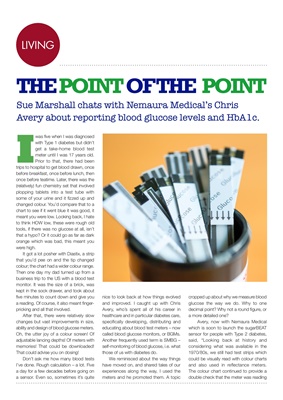
LIVINGLIVING
THE POINT OF THE POINT
Sue Marshall chats with Nemaura Medical's Chris
Avery about reporting blood glucose levels and HbA1c.
I
was five when I was diagnosed
with Type 1 diabetes but didn't
get a take-home blood test
meter until I was 17 years old.
Prior to that, there had been
trips to hospital to get blood drawn, once
before breakfast, once before lunch, then
once before teatime. Later, there was the
(relatively) fun chemistry set that involved
plopping tablets into a test tube with
some of your urine and it fizzed up and
changed colour. You'd compare that to a
chart to see if it went blue it was good, it
meant you were low. Looking back, I hate
to think HOW low, these were rough old
tools, if there was no glucose at all, isn't
that a hypo? Or it could go as far as dark
orange which was bad, this meant you
were high.
It got a lot posher with Diastix, a strip
that you'd pee on and the tip changed
colour; the chart had a wider colour range.
Then one day my dad turned up from a
business trip to the US with a blood test
monitor. It was the size of a brick, was
kept in the sock drawer, and took about
five minutes to count down and give you
a reading. Of course, it also meant fingerpricking and all that involved.
After that, there were relatively slow
changes but vast improvements in size,
ability and design of blood glucose meters.
Oh, the utter joy of a colour screen! Of
adjustable lancing depths! Of meters with
memories! That could be downloaded!
That could advise you on dosing!
Don't ask me how many blood tests
I've done. Rough calculation - a lot. Five
a day for a few decades before going on
a sensor. Even so, sometimes it's quite
nice to look back at how things evolved
and improved. I caught up with Chris
Avery, who's spent all of his career in
healthcare and in particular diabetes care,
specifically developing, distributing and
educating about blood test meters - now
called blood glucose monitors, or BGMs.
Another frequently used term is SMBG -
self-monitoring of blood glucose, i.e. what
those of us with diabetes do.
We reminisced about the way things
have moved on, and shared tales of our
experiences along the way, I used the
meters and he promoted them. A topic
cropped up about why we measure blood
glucose the way we do. Why to one
decimal point? Why not a round figure, or
a more detailed one?
Avery, now with Nemaura Medical
which is soon to launch the sugarBEAT
sensor for people with Type 2 diabetes,
said, "Looking back at history and
considering what was available in the
1970/80s, we still had test strips which
could be visually read with colour charts
and also used in reflectance meters.
The colour chart continued to provide a
double check that the meter was reading